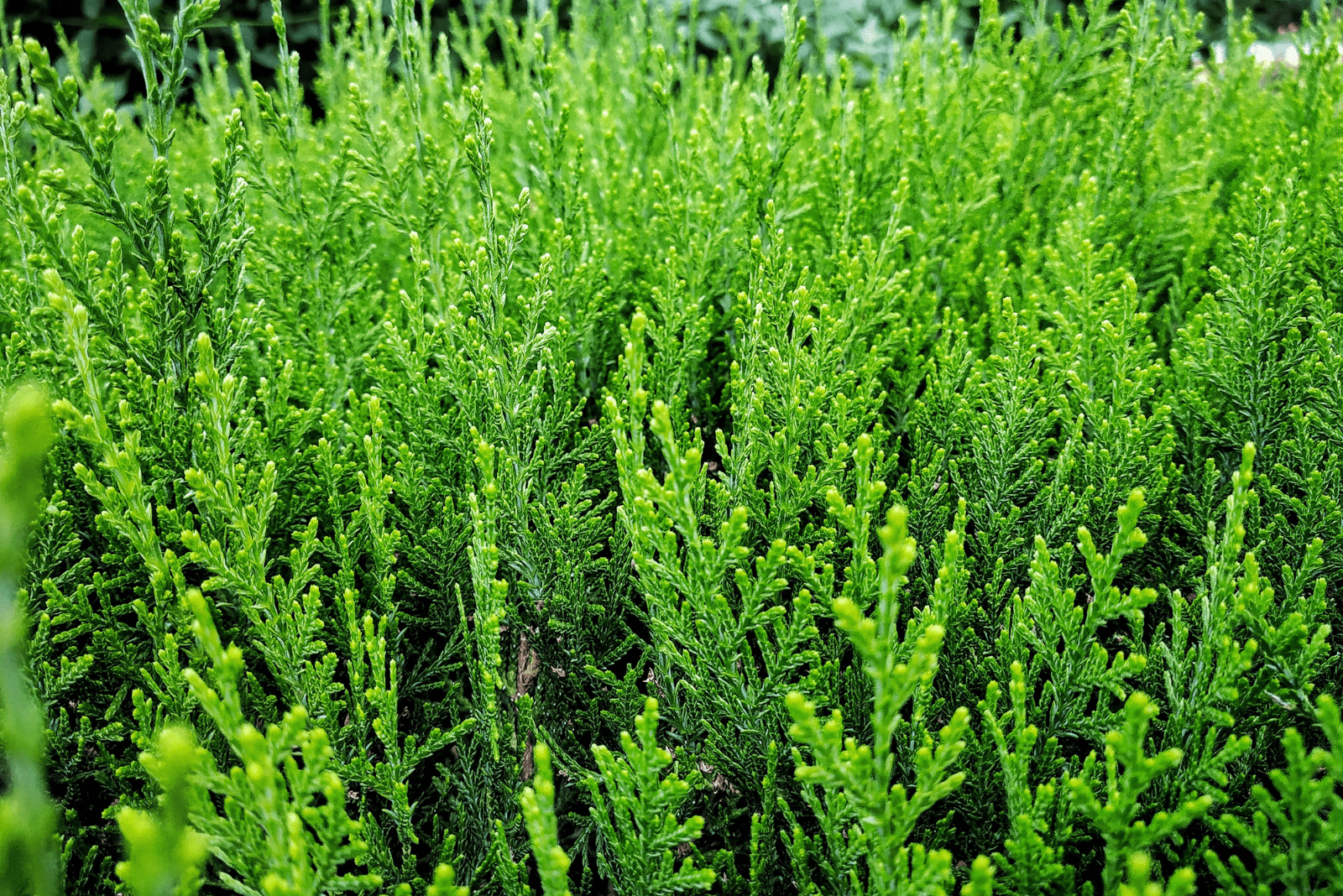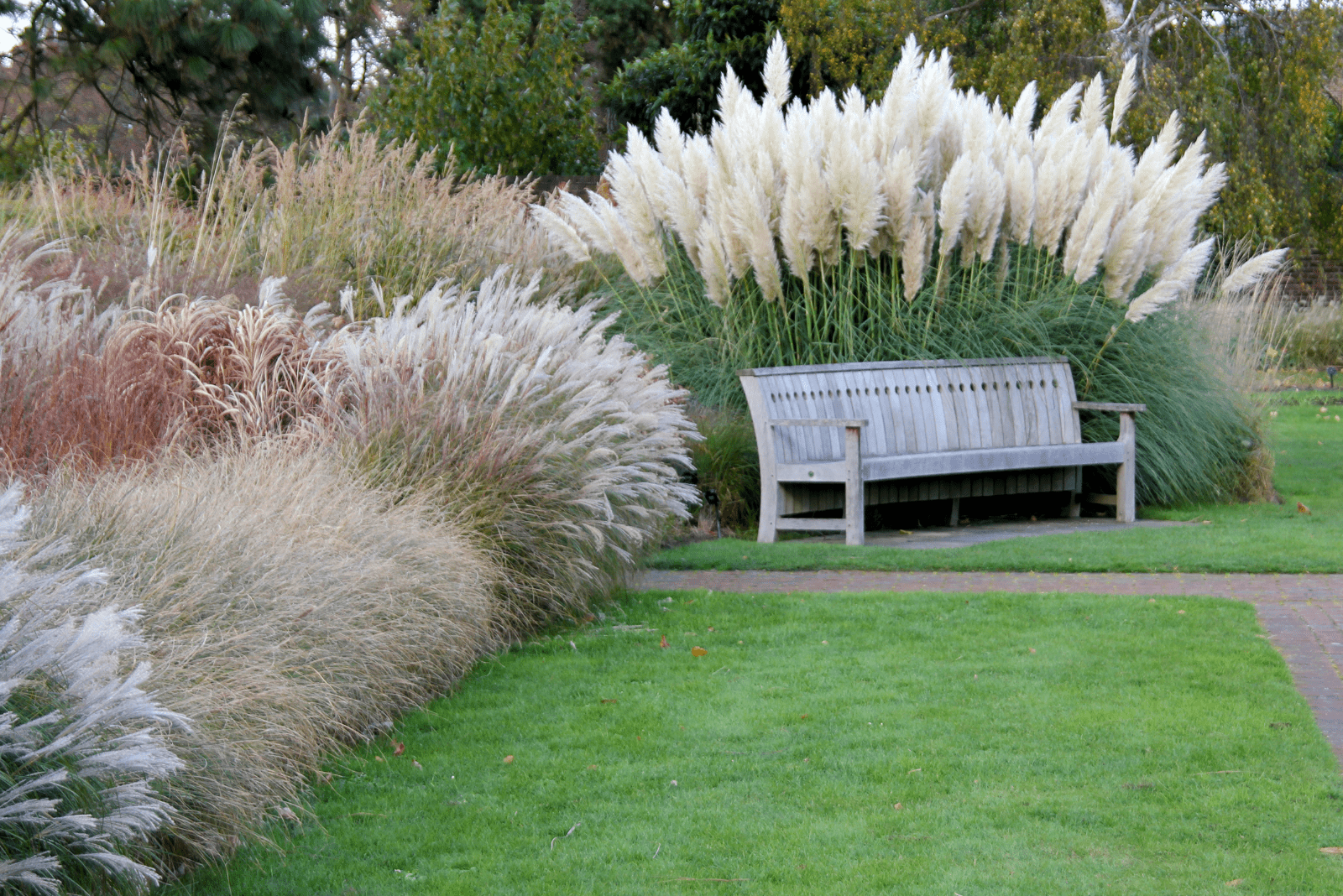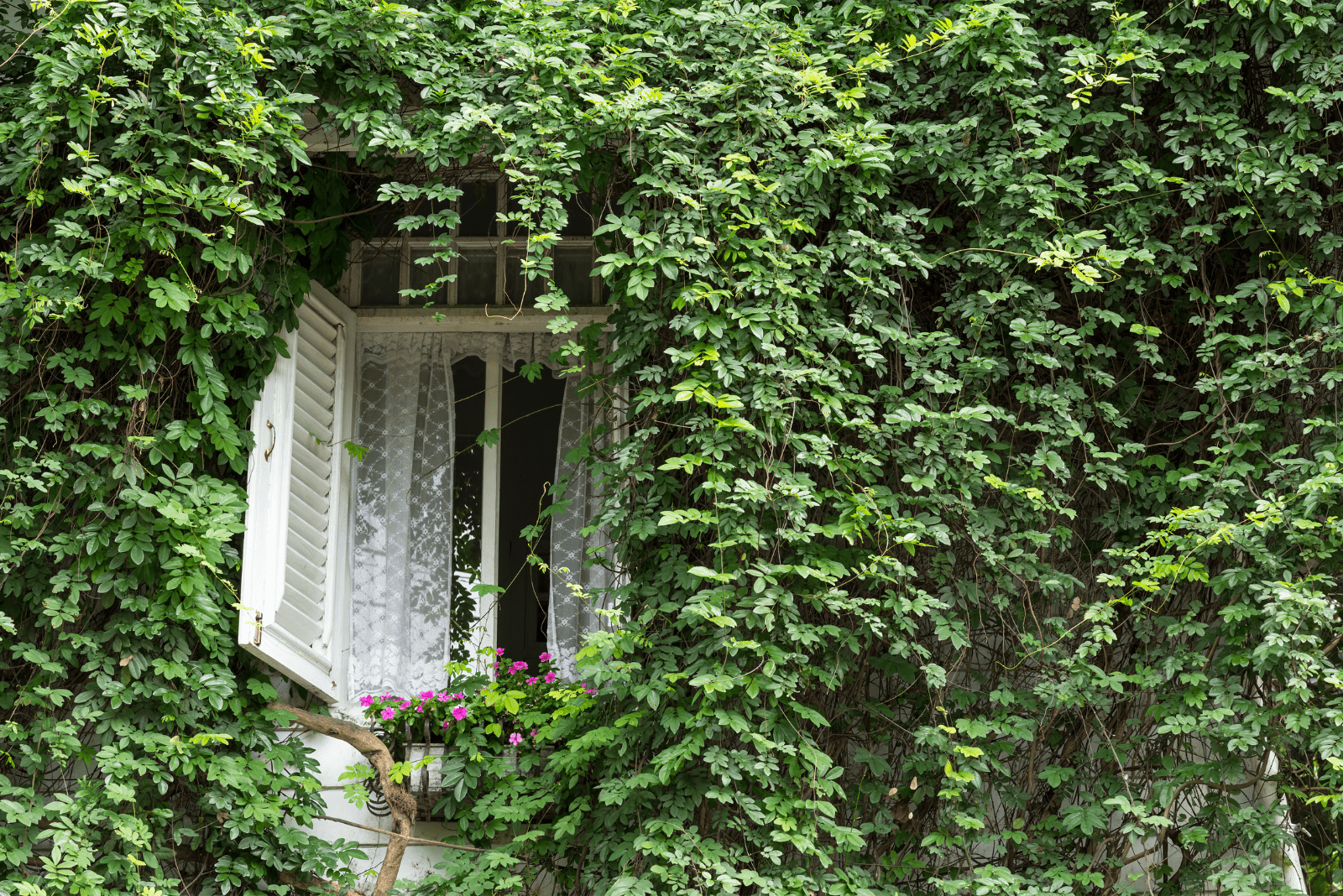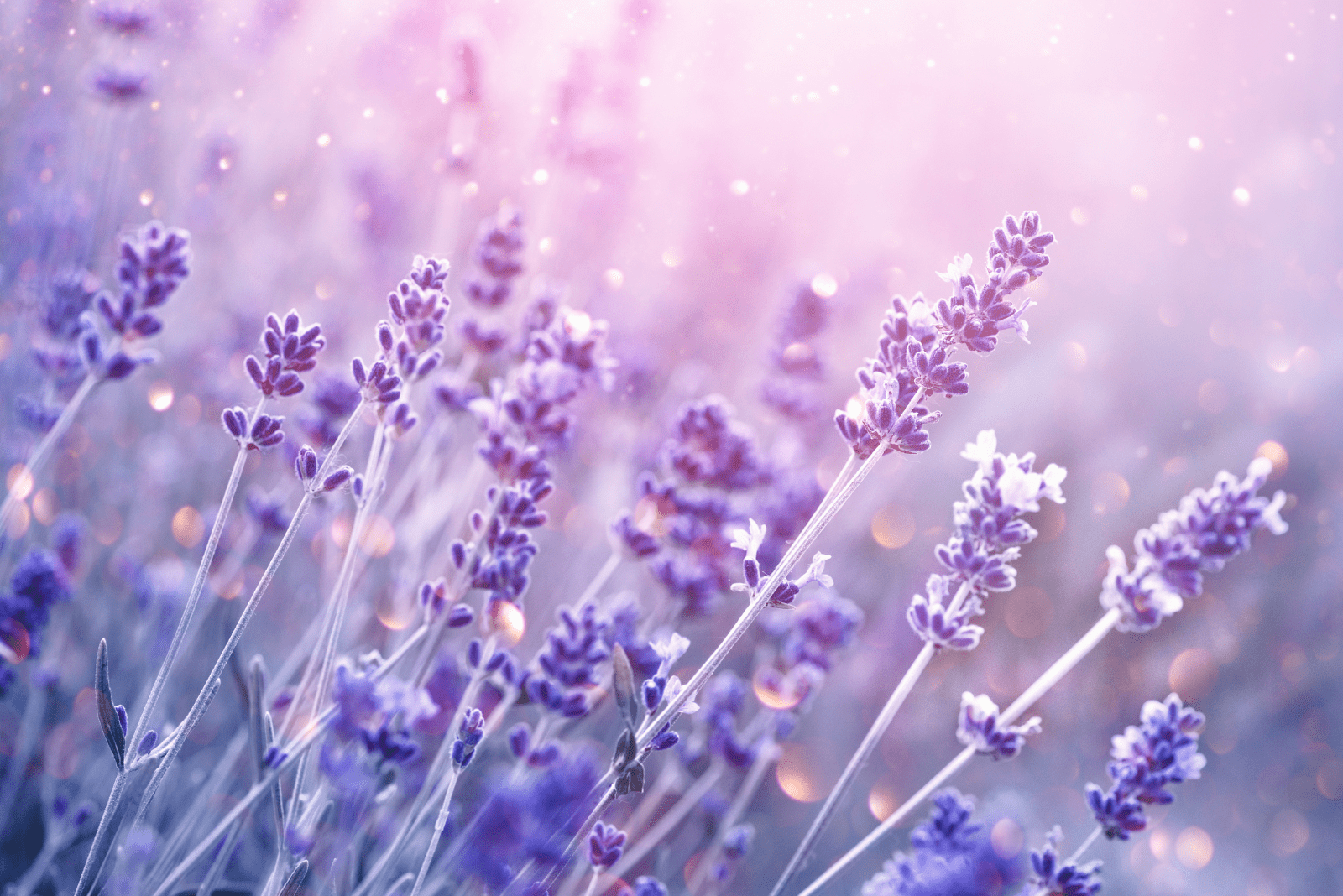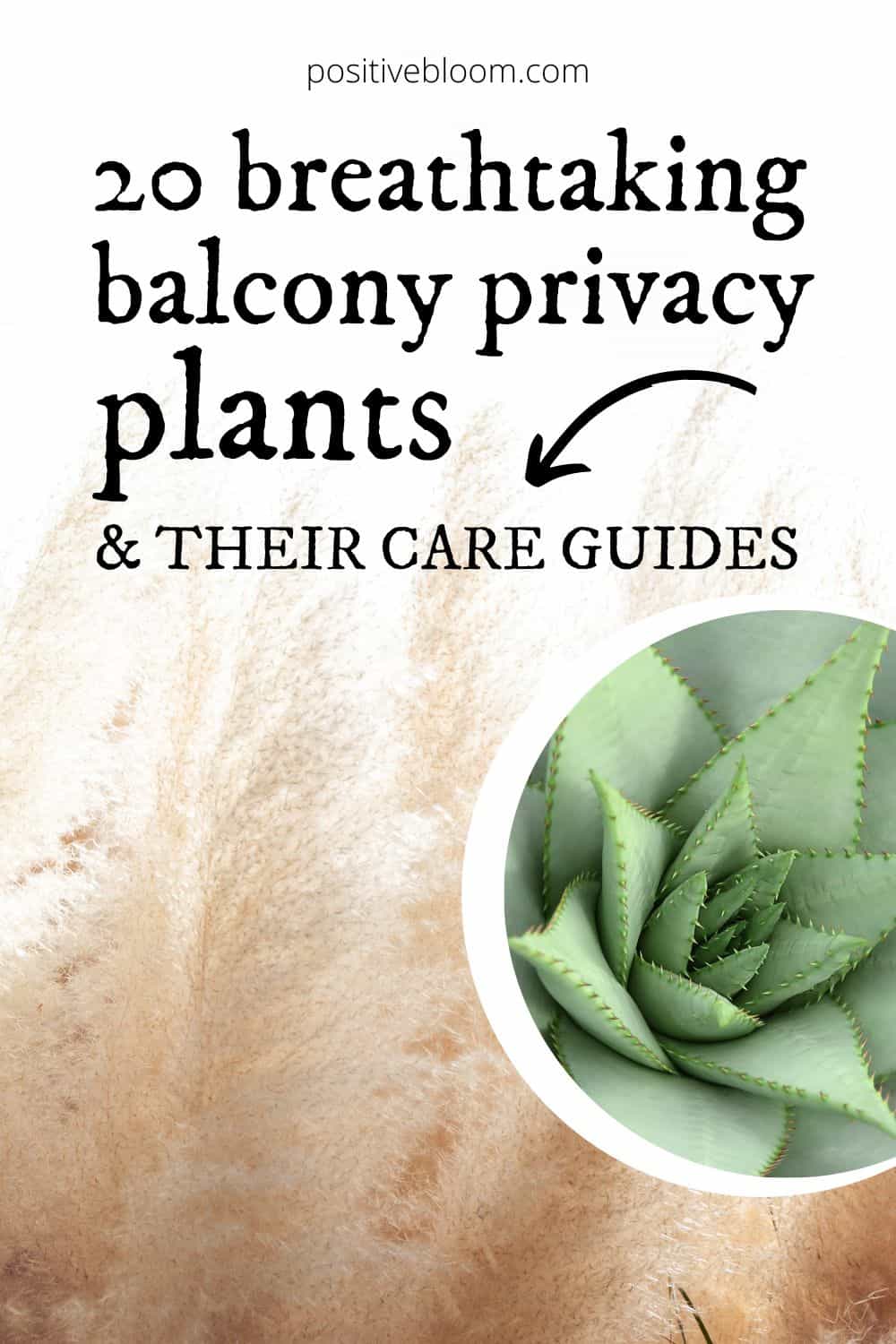Relaxing on a balcony with a good book in hand and fresh air around you is a form of apartment therapy. But there is a way to improve it!
Setting a privacy fence around your terrace is an excellent way to be more at ease, as there will be no prying eyes upon you.
There are many ways that you can achieve the desired separation from the outer world, but one of my favorite ways to do this is to grow some balcony privacy plants.
There are many green friends that you can place on your terrace that will adore the sunshine and the light summer breeze.
We’ll examine some balcony plants you can grow as a privacy screen and create a personal microcosm separate from the outside.
The following sections will include the plants’ basic needs, so you’ll immediately know whether they are suitable for your region.
So, let’s start!
20 Balcony Privacy Plants
There are many tall potted plants suitable for privacy screens that you can place on your patio or use as a hedge to frame the path leading toward your house.
But there are also varieties that you can use to hide the higher stories of your home, such as balconies.
We usually grow them in pots and large containers, but you can also plant them below your terrace and let them climb up.
Below, you’ll find the most popular balcony plants, such as climbers, ornamental grasses, and even shrubs.
Ornamental Grasses
Planting grasses on your balcony is a great idea and adds more splendor to your design while screening it from curious passers-by.
We’ve brought you five of our favorite tall grasses that will obscure the view to your balcony, but you can always experiment with others too!
1. Bamboo Plant
We often think of bamboo as a tree, but it is actually a very tall grass. There are many different cultivars, so you can choose whether you want a curly or a straight-growing one.
This plant is also very flexible, so you’ll have a choice between the varieties that can handle either freezing conditions or those that prefer mild temperatures.
Of course, if you don’t have a variety that can survive low winter temperatures, you can always take it inside over winter or even grow it as a houseplant.
Furthermore, there are also tall and bushy cultivars, which have different requirements. While the bushy bamboo plant may flourish in a 20 or 30-gallon planter, the tall variety needs a 40-gallon one.
Naturally, there are some particular requirements that you must fulfill in order to cultivate this grass, and you can learn what they are below.
[table id=350 /]2. Pampas Grass
Pampas grasses are large outdoor plants that grow rapidly and can reach a height of 10 feet. But thankfully, there are dwarf cultivars that are perfect for a smaller balcony.
These plants are quite sturdy and can tolerate all kinds of substrates, including salty ones, which explains why we see so many on the California coast.
Many gardeners choose this grass due to its ornate flower plumes, which can be silvery-white, creamy, sandy-pink, peachy, or bright yellow.
You can even plant a rainbow that will float in the light summer wind, but the flowers may even last into the winter if you live in warmer climates.
Furthermore, pampas grass should be planted in at least a 10-gallon container, but will eventually need more space. Thankfully, you can just divide its roots every 2–3 years without having to buy a larger pot.
[table id=351 /]3. Blue Dune Lyme Grass
This plant isn’t particularly tall (2 feet), but it can also grow to 2 feet wide, so you’ll have to find a place on the balcony that can fit it.
It also extends its plumes three feet in the air, meaning that you’ll still get some privacy on your apartment balcony.
Blue lyme grass is an excellent landscaping plant due to its attractive color. However, it can get invasive if you grow it in fertile garden soil, but it is perfect for container gardening.
Start it in a 10-gallon planter and divide its roots or repot it in a larger container in about two years.
It is a low-maintenance plant, but it still has some requirements that should be met if you want healthy blue grass decorating your balcony garden.
[table id=352 /]4. Japanese Forest Grass
This slow-growing plant usually grows to about 2 feet tall and 3 feet wide, and it can be a great way to emphasize the beauty of your small garden trees and outdoor space in general.
You can even grow it in containers, but you’ll have to ensure excellent drainage since this plant cannot stand wet soils. Thankfully, getting a well-draining mix and a pot with some drainage holes should be enough.
Plant it in a 10-gallon container to prevent water clogging and then increase the size when the plant doubles in size.
[table id=353 /]5. Fiber Optic Grass
Well, this is a plant that loves moisture, and you can grow it in containers or even in a pond or your water garden.
It also belongs to the list of plants suitable for self-watering planters since it doesn’t mind extra water around its roots.
It is usually a foot tall, but if you raise it to a higher position, it’s great at creating a barrier between your small world and the outdoor vastness.
It can be grown as a perennial in warmer regions, but you can always grow fiber optic grass as an annual plant wherever you are.
It will surprise you with its white flowers that appear from spring to fall, but you’ll always be able to enjoy its blue-green foliage.
If you have just brought this plant home from your local garden center, you can repot it once a year until the plant reaches its maximum size.
There are also other things you need to pay attention to, and you can find them in the following table.
[table id=354 /]Vining Balcony Plants
There are many fantastic DIY ideas for a vertical garden, and most of them include some kind of flowering plant wrapped around the balcony railing.
But how do you choose the perfect plant?
Well, there are many factors to consider, such as the plant’s hardiness zone, the amount of light it can get on your balcony, and the size of the terrace.
Therefore, we have included five different varieties that tend to everyone’s needs, whether you want some greenery or colorful flowers.
1. English Ivy
English ivy is a popular climbing plant that we see growing in forests, using trees to support their upward growth.
Therefore, we usually tend to connect it with a neglected property. However, English ivy can add so much to your home decor if you prune it regularly and prevent it from invading your house.
If you don’t like its look on the railing, you can always place a trellis inside the pot to get the best out of this fast-growing plant or grow it in a hanging basket.
Thankfully, it will take a couple of years before it starts developing quickly, so you’ll have more than enough time to figure all the details out.
Finally, repot it into a new container, 1–2 sizes larger than the previous one, because large planters may lead to water-clogging or slowing down the plant’s growth (the plant has to first develop a more extensive root system before developing new leaves).
[table id=355 /]2. Star Jasmine
Jasmine is famous for its white flowers and potent fragrance, but its glossy green leaves aren’t far behind.
It also wriggled its way onto a list of beautiful Italian flowers, so you can decorate your balcony like a home in Rome.
Jasmine grows to around 10–15 feet long, so you’ll have to control its growth to prevent it from devouring your house.
You can plant it in the ground and let it climb up to your balcony or grow it in a small pot with an unusual-shaped trellis.
As it grows, keep repotting it into a bigger planter, but ensure it has drainage holes and that it is never more than 2 sizes larger than the previous one.
[table id=356 /]3. Bougainvillea
Bougainvillea is that pink-flowered plant that grows in every Greek home, it seems.
It can grow to 20–30 feet tall with a bit of support and may produce signature pink, vivid orange, bright yellow, mesmerizing pink, and pure white flowers.
The bougainvillea thrives in hot places, so it’s possible to admire its blossoms from November to May.
You can set up a trellis or let it climb up the wall all the way to your balcony.
It benefits from being slightly restricted, so plant it in a smaller pot and always move it into a container that’s only one size larger when the time comes.
[table id=357 /]4. Pothos
There are many different pothos plants out there, so knowing the differences between the Hawaiian and golden pothos before getting them can help you decide on the ultimate appearance of your balcony.
You can grow these evergreen plants in hanging baskets or let them trail over your balcony railing.
They don’t need large pots, but you will have to repot them every 1–2 years so they can keep growing.
They usually grow up to 20 feet in non-tropical regions, but you’ll still have to prune them from time to time to get rid of dead leaves and control their size.
Of course, pruning is not the only requirement these plants have, but you can find out more about them in the following table.
[table id=358 /]5. Flame Vine
The flame vine bears fiery orange flowers from fall to early spring, so it’ll add a breath of life during dreary periods.
It grows to about 6–12 feet tall and prefers trailing on a balcony railing or any form of scaffolding you might have at home.
You can even grow it in a pot; you just have to water it more frequently. However, you’ll have to prune it once a year to remove all the dead parts and keep it in shape.
There are also some other things that you’ll need to pay attention to, but you can learn about them below.
[table id=359 /]Best Evergreen Shrubs For A Balcony
If you’d like a bit more privacy, you can always choose some dense evergreen plants, such as shrubs.
Below, you can read about our all-time favorite varieties, but there is always room for more!
1. Lavender
Lavender is native to the Mediterranean, meaning that it thrives in hot and dry climates. However, growing lavender plants in Florida, for instance, is not unheard of; you just have to choose the proper variety, such as French lavender, and ensure proper drainage.
It is much easier to grow this plant in a container where you can control the moisture more easily.
Lavender also has a strong scent, so it’ll easily repel mosquitoes and provide you with the aromatherapy everyone deserves after a long day.
Finally, this plant is drought-tolerant when established, so if you have planted it in the ground, you’ll only have to irrigate it during dry spells.
[table id=360 /]2. Hydrangea
This stunning flowering plant may bear white, green, pink, purple, or blue blossoms.
Shorter hydrangea plants are perfect for balconies as they reach a maximum height of 3 feet, but you can always select a larger variety if you have the room.
This member of the floral kingdom doesn’t have deep roots, so you can easily grow it in a planter.
It is not too demanding, but you need to meet a couple of requirements to ensure you get the best blossoms.
[table id=369 /]3. Boxwood
Boxwood usually grows to around 15–20 feet tall, but it is a bit smaller when you grow it in a pot, so it’s a perfect privacy plant for a balcony.
It doesn’t grow too fast, so you won’t have to repot it every year. However, it does need good drainage, but this can be easily fixed with premium quality soil and some drainage holes at the bottom of the planter.
Also, ensure that the container is larger than the boxwood’s root system and that it has all the conditions for the best growth, such as the ones described below.
[table id=361 /]4. Arborvitae
One of the best tall plants for balcony privacy is arborvitae.
Now, I know what you’re thinking! This pine-like tree cannot possibly look good on a terrace! But that’s where you’re wrong! It can blend in quite nicely into contemporary decor.
All you need is a large planter, preferably a 20-gallon one so that its roots can easily spread.
There are a couple of other things you should pay attention to when growing this plant in a container, and you can learn them in the table below.
[table id=362 /]5. Fuchsia
There are climbing fuchsia cultivars, but it looks stunning as a shrub, so why not get one to decorate your balcony and give you some privacy at the same time?
I mean, you won’t even have to trim it other than removing the dead parts, which have no good reason to be on your plant in the first place.
When planting fuchsia in a container, make sure it has a few drainage holes since this plant is prone to overwatering and root rot.
I do have to mention that this plant is grown as an annual in most climates, as it’s not cold hardy, but it grows rapidly, and you won’t have to wait too long until it shows its vibrant flowers.
[table id=363 /]Other Tall Balcony Plants
There are many other plants that cannot be really seen as vines or shrubs (and they are definitely not grasses), but that can still give you some privacy.
Below, you can read more about succulents, ferns, hollyhocks, marigolds, and palm trees that can transform your balcony into a place you’ll never want to leave.
1. Succulents
We’re used to growing succulents as indoor plants, but there’s no reason why we shouldn’t take them outside if the weather is nice.
Echeverias, agave, and jade plants are perfect balcony plants, and you can decide which one to grow depending on their light requirements.
(But let me say, echeverias have amazing flowers, and it would be a shame to miss out on them).
Some of them can grow very tall (such as a century plant which can grow up to 6–8 feet tall), but there are shorter varieties to choose from too.
And if you need something to treat sunburns, you can always grow an aloe vera plant!
Of course, these plants can’t handle soggy soils, so make sure to plant them in a well-draining potting mix and a planter with drainage holes.
[table id=364 /]2. Boston Fern
There are many Boston fern cultivars in the world, but the Fluffy Ruffle fern is one of the most attractive varieties and can look amazing on your balcony.
It looks great in a terracotta pot or a hanging basket, but it does need good drainage to flourish.
Its dense green fronds look like miniature swords, but they won’t cut you!
There are a couple of things you need to look out for when growing this plant, and you can learn what they are in the following table.
[table id=365 /]3. Hollyhock
Hollyhock is a tall plant that usually grows to around 6–8 feet. It also has a deep and extensive root system, so you’ll have to look for a pot that is at least 2 feet in diameter and about 16 inches deep.
But if you don’t have such a massive planter, you can always choose a dwarf variety with slightly smaller roots.
But their white, pink, red, purple, blue, and black blossoms make them irresistible to many growers, so we are willing to go the extra mile to make them comfortable.
They start blooming in mid-summer to early fall, and if you pair it with some earlier-flowering varieties from above, you’ll enjoy your blooming balcony garden for quite some time.
Of course, you do have to care for it to get the maximum amount of blossoms possible, so we’ve brought you its basic requirements below.
[table id=366 /]4. Marigold
Privacy plants in pots can transform the appearance of any balcony, especially if they have vibrant colors like marigolds.
This variety is a perfect plant for a railing planter and window boxes since it’s rather short, but you can get taller varieties as this plant ranges between 6 inches and 3 feet.
If you want to plant regular-sized marigolds, such as French or African varieties, use a 10-inch pot (minimum). However, there are dwarf cultivars that are perfect for 6-inch planters.
Finally, these plants love moisture, so you can even grow them in self-watering containers for the best results.
[table id=367 /]5. Majesty Palm Tree
The last plant suitable for balcony privacy is the majesty palm. This amazing variety is usually grown indoors, but it can survive all year long in tropical and subtropical climates.
Of course, if you live in cold regions, you can take this plant outside once the weather gets warm enough and take it back inside once the cold winds bring a taste of winter.
It can grow up to 80 feet tall in its natural habitat, but container plants are usually limited to 8 feet tall.
It does need excellent drainage and good food, which is why it is crucial to pick the right majesty palm tree fertilizer that is rich in nitrogen and potassium and contains some micronutrients such as manganese, iron, and magnesium on the side.
[table id=368 /]Faux Plants
Plants are an excellent way to get some privacy on your balcony, but you don’t necessarily have to use live plants to create a privacy screen on your terrace.
Artificial plants and bamboo blinds are an excellent way to hide from the rest of the world while relaxing and enjoying your time off.
Even though they are not alive and not as attractive as the real thing, faux plants can still give you that desired privacy and don’t require any sort of maintenance.
These plants are therefore suitable for anyone who lives “on the go” and doesn’t have too much time to spend watering, pruning, feeding, and overall tending to their green buddies.
However, artificial plants will fade after some time, so you’ll have to replace them eventually.
How To Choose The Best Balcony Plants
The last thing we need to discuss is the best way to choose the perfect plant for your terrace.
There are a couple of things you need to take into consideration, and we’ll discuss the most important ones.
The first thing you should look out for is if the plant thrives in your USDA zone. You’ll have to spend a lot less time caring for this plant, and you won’t have to move it indoors over winter.
Another thing to consider is the amount of light that the plant needs. If your balcony faces northwards, choose fuchsia or another plant that can thrive in the shade. But if you have a well-lit terrace, you can grow succulents, palm trees, marigolds, and many other flowering plants.
The size of the plant is also important. If you have a smaller balcony, you should choose smaller plants, so you don’t overcrowd it. But if you have room, there’s nothing stopping you from getting an arborvitae shrub!
Finally, many growers consider plant maintenance before getting a new friend. If you lead a busy life, opt for low-maintenance plants such as succulents or lavenders, as they don’t require frequent pruning and watering.
Of course, there are many other things that people think of when choosing a new plant for their balcony, such as drainage, but the ones above play an essential role.
Final Thought
This article has examined many gorgeous and popular balcony privacy plants. We included their most prominent features and introduced some of their basic requirements so that you can choose the one that’s perfect for you.
It might be a bit strange, but we also presented faux plants as an option for busy bees as they, too, can give you privacy if that’s all you need.
Finally, we brought you a few tips for choosing the best balcony plant, such as considering their size and the size of the balcony, the plant’s light requirements, overall maintenance, and the USDA zone in which it thrives.
There’s a plant on this list for everyone!
Enjoy, and until next time!
Like this post? Share or pin it for later!

